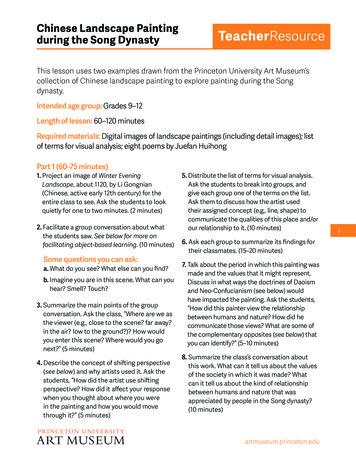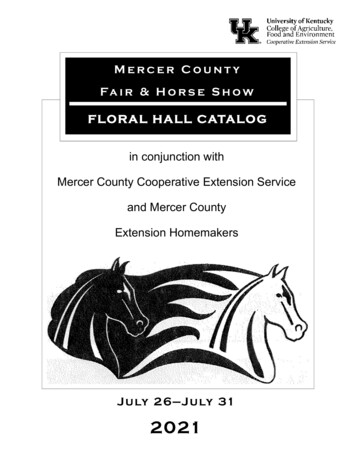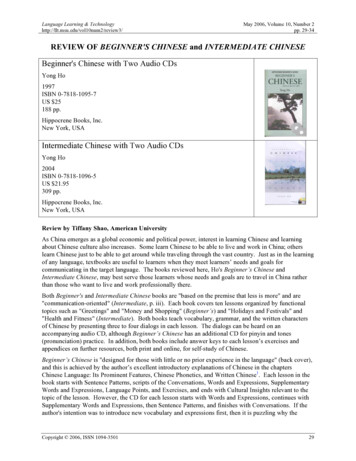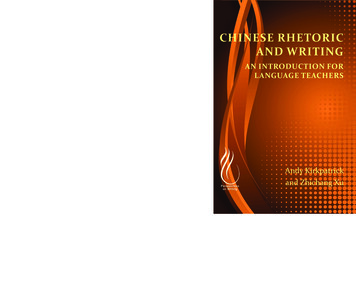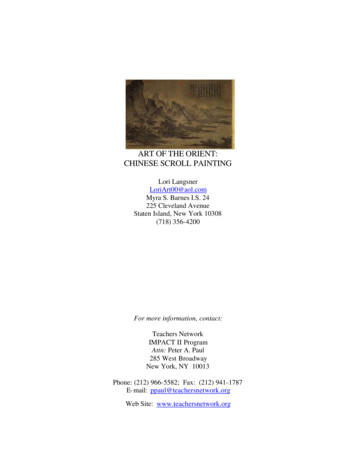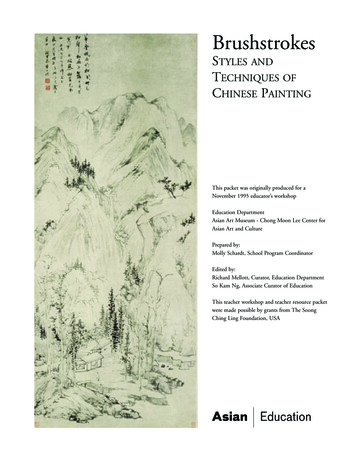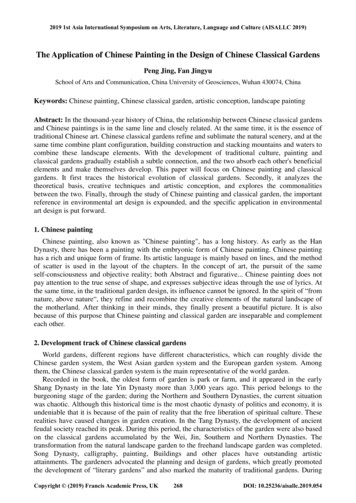
Transcription
2019 1st Asia International Symposium on Arts, Literature, Language and Culture (AISALLC 2019)The Application of Chinese Painting in the Design of Chinese Classical GardensPeng Jing, Fan JingyuSchool of Arts and Communication, China University of Geosciences, Wuhan 430074, ChinaKeywords: Chinese painting, Chinese classical garden, artistic conception, landscape paintingAbstract: In the thousand-year history of China, the relationship between Chinese classical gardensand Chinese paintings is in the same line and closely related. At the same time, it is the essence oftraditional Chinese art. Chinese classical gardens refine and sublimate the natural scenery, and at thesame time combine plant configuration, building construction and stacking mountains and waters tocombine these landscape elements. With the development of traditional culture, painting andclassical gardens gradually establish a subtle connection, and the two absorb each other's beneficialelements and make themselves develop. This paper will focus on Chinese painting and classicalgardens. It first traces the historical evolution of classical gardens. Secondly, it analyzes thetheoretical basis, creative techniques and artistic conception, and explores the commonalitiesbetween the two. Finally, through the study of Chinese painting and classical garden, the importantreference in environmental art design is expounded, and the specific application in environmentalart design is put forward.1. Chinese paintingChinese painting, also known as "Chinese painting", has a long history. As early as the HanDynasty, there has been a painting with the embryonic form of Chinese painting. Chinese paintinghas a rich and unique form of frame. Its artistic language is mainly based on lines, and the methodof scatter is used in the layout of the chapters. In the concept of art, the pursuit of the sameself-consciousness and objective reality; both Abstract and figurative. Chinese painting does notpay attention to the true sense of shape, and expresses subjective ideas through the use of lyrics. Atthe same time, in the traditional garden design, its influence cannot be ignored. In the spirit of “fromnature, above nature“, they refine and recombine the creative elements of the natural landscape ofthe motherland. After thinking in their minds, they finally present a beautiful picture. It is alsobecause of this purpose that Chinese painting and classical garden are inseparable and complementeach other.2. Development track of Chinese classical gardensWorld gardens, different regions have different characteristics, which can roughly divide theChinese garden system, the West Asian garden system and the European garden system. Amongthem, the Chinese classical garden system is the main representative of the world garden.Recorded in the book, the oldest form of garden is park or farm, and it appeared in the earlyShang Dynasty in the late Yin Dynasty more than 3,000 years ago. This period belongs to theburgeoning stage of the garden; during the Northern and Southern Dynasties, the current situationwas chaotic. Although this historical time is the most chaotic dynasty of politics and economy, it isundeniable that it is because of the pain of reality that the free liberation of spiritual culture. Theserealities have caused changes in garden creation. In the Tang Dynasty, the development of ancientfeudal society reached its peak. During this period, the characteristics of the garden were also basedon the classical gardens accumulated by the Wei, Jin, Southern and Northern Dynasties. Thetransformation from the natural landscape garden to the freehand landscape garden was completed.Song Dynasty, calligraphy, painting, Buildings and other places have outstanding artisticattainments. The gardeners advocated the planning and design of gardens, which greatly promotedthe development of “literary gardens” and also marked the maturity of traditional gardens. DuringCopyright (2019) Francis Academic Press, UK268DOI: 10.25236/aisallc.2019.054
the Yuan, Ming and Qing Dynasties, the inheritance and development of the past gardens created afusion of the north and south and other regions represent the garden style of the genre. Landscapeand architecture, poetry and painting have reached a perfect height in the history of art. From theoriginal rituals, the traditional gardens have the mysterious imperial power to the literati gardens ofthe Southern and Northern Dynasties; from the pure appreciation of natural beauty to theappreciation of artistic beauty; from the admiration of luxurious royal gardens to the pursuit ofelegant and simple temple gardens, the development of traditional gardens along with people'saesthetics Development of ideas. The construction of the traditional garden style system passeddown from generation to generation has finally bred in the long river of traditional culture.Table 1 Historical Table of Chinese Classical GardensDynastyYin Zhou (formerly1600-before 256)The Wei, Jin andSouthern and NorthernDynasties (220-589)Tang and SongDynasties (618-1279)Yuan, Ming and QingDynasties (1260-1911)characteristicsappeared part or farm, the sprout ofclassical gardenscombine landscapes, plants and buildingsinto a landscape garden.From Natural Landscape Garden toFreehand LandscapeThe exchange and development ofChinese and Western cultures promotedthe diversity and creative development ofgardens.(Source of the form: the author self-painted)main achievementsLingbi, Linguma, LingtaiHualin Park, Qinglin Court,Sangyuan Court, Xu Garden,and Diyuan CourtGarden Forbidden Court,Cuiwei Palace, JinmingchiLion Forest, Taiyuan,Summer Palace3. The Origin of Chinese Classical Gardens and Chinese PaintingsGarden and Chinese painting are our unique art forms. Their natural aesthetics are the basis ofunderstanding. Historically, more gardeners are literati and scholar-officials, the country'scorruption, the turmoil of the current situation, in order to express their hearts and minds, and lovein the mountains and rivers. Seeking a spiritual relief. So they actively invested in the gardeningactivities and applied their achievements in painting and calligraphy to the construction of thegarden. The technique of “drawing into the garden and painting into the landscape“ began to appear,and the paintings and classical gardens began to infiltrate and blend. It can be seen that in theevolution of classical gardens, Chinese painting has played a significant role in the process ofgardening. Because they are all objects of natural scenes, they are pursuing the creative tenet of“teaching nature, above nature“. It is precisely because of these historical factors and creativecommonalities that Chinese paintings and Chinese classical gardens have quite similarities. Next,we will discuss the same place between the two.3.1 teacher law is natural, higher than nature"Teaching the Fa" is the experience, refinement and summarization of the gardener's naturalscenery. It is expressed by natural elements. The word “park“ reveals the three elements of classicalgardening-architecture, landscapes, and flowers. The role of these three elements in the creation ofgardens is undoubtedly crucial, but the landscape of Chinese classical gardens is not only thereproduction of nature, but the subject matter after subjective processing. Therefore, we cannotsimply generalize the creation of gardens into simple substances, but also include the spiritualmaterialization of gardeners. In Chinese landscape paintings, different plants have different symbols,Meilan Zhuju, Chinese ancients are known as "four gentlemen", plum symbolizes high and strong;blue symbolizes light and elegant; bamboo symbolizes high wind and bright festival; The plantingof classical gardens can use symbolic techniques, and the gardeners use this technique to expresstheir emotions. The Canglang Pavilion in the Suzhou Garden has planted a large number ofbamboos. The idea of gardening is to take the symbol of bamboo - high wind and bright festival, in269
order to express the elegant character of the gardener's indifferent fame and fortune. This symbolicapproach is not only a need for landscaping, but also a way for people to understand nature and toexperience the nature of "teaching the law."Although Chinese painting is a static art, their creation is not simply a reappearance oflandscapes. Instead, the artist carefully extracts the elements and then displays them on the screenthrough careful observation of natural landscapes.3.2 Creation of artistic conceptionArtistic conception refers to the scenes that exist in people's brains, but there are differentunderstandings and perceptions for different appreciators. In classical gardens, the creation ofartistic conception requires the unique design of the gardener, and also requires a great connectionbetween the aesthetics of the viewer. The gardeners will create the artistic conception of differentatmospheres through the space, color, sound, smell and texture of the garden. Combined withcalligraphy, engraving, plaques, couplets and other texts to further express the meaning of theconception.In the creation of Chinese painting, the painter carefully observes the scenery, thus forming hisown understanding of the landscape, and then manifests himself on the drawing paper throughvarious painting techniques. For example, the classic work of the famous modern artist Qi Baishi,"Frog Sounds Ten Springs", the game in the spring of the spring, naturally makes the viewersappear in the frog sound scene not far from the ear. A few strokes, turning the originally limitedscene into a space-infinite mood, this is the charm of the mood, it is not touched, can not grasp, butthe real origin from the observation of life. The beauty of the artistic conception of Chinese painting,the subtle conveyance of beauty in the whole painting, is illusory and real, and has the mysteriousfeeling that people feel "still immersed in half-faced", which is infinitely imaginative and endless.3.3 Organic combination of natural beauty and architectural beautyThe garden architecture in Chinese classical gardens is rich in cultural significance. Thecombination of architecture and landscape creates a colorful garden landscape. Garden architecturealways attaches importance to the organic integration with the surrounding environment to achievea high degree of integration with nature. As early as in the Eastern Jin Dynasty, the architecturalhabits of the people included the layout of the house according to the terrain. All the buildings in thegarden should be in harmony with the surrounding vegetation, rockeries and water bodies. “Becausethe mountain pavilion“ is to build the pavilion according to the height of the terrain and theperspective of the space, so that the building should be like this. On the basis of respecting thecharacteristics of the place, we will maximize the realization of the space to achieve the effect ofviewing.In Chinese painting, landscape painting mainly takes the elements of flowers, landscapes, boats,buildings and other elements in the natural environment as objects of creation. However, in thepicture, there is not only a natural landscape element, but the building also plays an important rolein the overall picture effect. A few strokes, through the small freehand way to outline the shape ofthe pavilion, not only can enrich the effect of the entire picture, but also play a finishing touch to thecreation of the sense of space.Table 2: Comparison between Chinese painting and Chinese classical gardenContentChinese paintingChinese classical gardenPerformance elementsink and paperconstruction, landscape,plantsBasic classificationbrushwork, freehand painting artificial landscape garden, natural landscape gardenCreation methodtwo-dimensional spacethree-dimensional spacePerception modevisualtouch, sight, hearing, smellExpressingBoth form and spiritDynamic and static combination(Source of the form: the author self-painted)270
4. Application of Chinese painting in Chinese classical gardens4.1 Application of landscape painting in Chinese classical gardensThe Northern and Southern Dynasties are destined to be a repetitive, continually dynasty in thereplacement of social forms. The literati in this era saw the disastrous homeland, attempted toescape the reality, pinned their ideals and ambitions in the mountains and waters, and placed theiremotions in the natural scenery, so that the landscape paintings began to slowly reveal andProsperous. The original landscape paintings exist only for the portrait paintings. With thedevelopment of time, the landscape has gradually separated into a category of Chinese painting, andit has continued to grow and develop.During the Qin and Han Dynasties, landscape paintings gradually revealed. The earliestlandscape paintings of the world are the masterpieces of the famous painter Gu Yuzhi of the JinDynasty: "Female History" and "Luo Shen Fu Tu", but it exists in the background of the picture.The landscape paintings of this period are closely related to the figure paintings, but they also havea certain influence on the development of later landscape paintings.Landscape painting is a complete process of the artist's observation, conception and layout on thedrawing of the natural scenery, thus giving us a beautiful landscape painting. There are manysimilarities between the creation of landscape painting and the construction of Chinese classicalgardens: firstly, the connotation is determined, and the elements of landscape are very similar tonatural landscapes, “from nature, higher than nature“; secondly, designing these landscape elements,how to All kinds of placement and placement need to be considered and considered. In the garden,the stone is the same as the brushwork of the landscape painting.In landscape painting, stone is an indispensable element. Scholars and literati create their ownunderstanding through the careful observation of the shape and texture of stone in nature. Whenpainting, the painter will select different ink and ink techniques to achieve the effect according tothe effect of the picture. In landscape painting, the brushwork can be summarized into five kinds:“hook“, “皴“, “wipe“, “dye“, “dot“. Different strokes will also have different screen effects. Forexample, “皴“ refers to the trick, the most flexible technique used in this style. Through thecontinuous summarization of the swearing method of the literati in the dynasty, it graduallyimproved in the Song Dynasty, and various methods such as “wearing paralysis“, “chaosparalysis,“ “big axe,“ “small axe, etc.“ emerged. , added the French and French collection oflandscape painting. Living in the Song Dynasty painter Su Dongpo, the painting of the ink paintingsof the Song Dynasty is a strange stone in the lower left corner. The texture of the stone is expressedby the smashing method. It is suspected that the waves are tumbling; the dead trees are twisted andknotted, and they are inserted into the sky. The whole picture has no extra decoration, but it canmake people focus on the strange rocks and dead trees of the picture. When enjoying this painting,they can feel a tenacious vitality, although it is expressed by the image of Xiaosuo. This painting islike a person. Although he is in a desperate situation, he can still feel a kind of vitality. This is alsothe author's situation, which conveys the author's unwillingness to follow others and elegant lifeambitions.Just as painting has a brushwork, there will be traces in the construction of gardens and rocks.The stacked stone has a unique aesthetic connotation and strong artistic value, so it has been widelyused. The significance of rockeries for Chinese gardens is like sculpture for foreign gardens. HuangGongwang’s “Fuchun Mountain Residence“, one of the “Yuansijia“, uses the techniques of theparadox to reveal the shackles of the mountains and rivers. Chinese classical gardens also draw onthis method of defamation in the construction. When the gardeners carry out the Lushan Mountain,they must first construct the stone. When selecting the stone, the scorpion method is used to expressthe shape and texture of the mountain stone, and to achieve the artistic conception of the virtualreality. Of course, not all of them rely on the real mountain to build, rockery, at this time you canplay the role of the true mountain. During the construction, the natural mountain is mixed withrockeries and earth mud to cover up the elements of artificial carving, “peaks and harmony, and271
self-peak“. Intertwined without being messy, thus achieving the purpose of setting the scene, whichis similar to the pen-like method of using the pen.Table 3: Classification and characteristics of stacked stonesClassificationCharacteristicsLake stone classexquisite and transparent, graceful and gracefulYellowstoneangular and square, with masculine beautyOval stoneround and hardSword stonea sword-like peak formed by one-way cleavage of rockAbsorbent porouscapable of adsorbing moisture(Source of the form: the author self-painted)4.2 The application of freehand drawing in traditional gardensFreehand drawing is one of the types of Chinese painting. Compared with meticulous painting, ithas the characteristics of unrestrained, simple and detached, emphasizing the flexibility and changeof the pen method. It is both subjective and objective. It is both figurative and abstract. The focus ison the subjective feelings of the artist when he creates it, so it is called “freehand“. Ma Yuan, one ofthe representatives of the "Four Southern Song Dynasty", his representative painting "The ColdRiver Single Fishing Figure" broke the traditional painting method. The lonely boat floated on theriver surface, and the fisherman alone in the river, A few pens, all around, leaving white, the focusof the vision is concentrated on the fishermen of Zhoushan, setting off a scene of depression. Thiskind of composition is not only a kind of expression of the picture, but also the artist'sunderstanding of this conception. Through a lot of blank space, it creates a kind of ambiguousatmosphere. Therefore, his special layout method is called "the corner of the horse."The unique charm of Chinese landscape gardens lies in “freehand“. Chinese classical garden is anart of operating space. The use of white space in freehand painting in Chinese traditional gardens iswall hanging, that is, white powder wall. The gardener uses the white wall as the drawing paper,and uses the plants, rocks and window views as the pen and ink to create a landscape with a blendof scenes, real and false, and profound charm. At the same time, the Chinese painting uses themethod of scatter perspective in the layout of the chapter and the law. There is a big difference inangular perspective. This perspective relationship is not only reflected in the layout of the paper, butalso in the space. The five-generation Southern Tang Dynasty painter Gu Yuzhong’s "Han Xi ZaiNight Banquet", through the depiction of Han Xi's banquet, guests, although the protagonist is atdifferent time periods of the banquet, but through the white space in the picture, the characters canbe quickly distinguished from the sky and time. . The embodiment of this traditional chapter layoutin the garden is “step-and-step change“. As the footsteps change, the scenery that is reflected in theeyes will change accordingly. When the gardener is designing, through the arrangement of thestreamline of the garden, the “one step and one scene” viewing effect will not have the “onethousand side” view. The use of white space in traditional gardens not only creates a sense ofrhythm for the creation of the artistic conception of the space, but also leaves the audience withunlimited space for imagination and intriguing.5. The contemporary charm and development of Chinese classical gardensChinese classical gardens and traditional Chinese paintings are precious assets in the course ofhistorical development. There are many similarities between the two. From the perspective of thecontradiction in the sameness, the two are mutually infiltrated and interdependent. The theory ofChinese painting has guiding significance for the construction of Chinese classical gardens; Chineseclassical gardens are in a certain sense It is a pair of "Chinese paintings."The interpretation of Chinese classical gardens will encounter many factors: feudal socialpolitics, economy and political power, which will play an important role in the evolution of Chineseclassical gardens. Nowadays, the development of Chinese classical gardens is no longer just for theimperial powers and nobles, but also for the cultural carriers that are acceptable to our public. Not272
only that, but the gardens will also be modern with us. The development of the landscape slowlymerges into one. In the face of rapid changes, how do we make good use of the essence of these, tolearn the nutrients of traditional gardens to increase the number of things, or we need to continue toexplore the subject. In the beginning of the new era, designers should base themselves on theirnational conditions, take Chinese traditional culture as their roots, foster strengths and circumventweaknesses, and oppose historical nihilism and national nihilism. Similarly, they should absorbforeign fine cultures to fill them. I am making new achievements in the progress of the worldgarden.References[1] (US) Ian Lennox McHag. Design combined with nature [M]. Tianjin University Press, 2006.[2] Zhou Weiquan. History of Chinese Classical Gardens. Tsinghua University Press, 2008.[3] (Ming) Jicheng. Yuanye Notes. Chen Zhi, Notes. China Construction Industry Press, 1981.[4] Peng Yigang. Analysis of Chinese Classical Gardens [M]. Beijing: China Building IndustryPress, 2008.[5] Zang Zhigang, “The Influence of Chinese Painting Theory on the Layout of ClassicalGardens“ Journal of Beijing Institute of Technology (Social Science Edition) 2005.[6] Cao Linyi. Chinese garden culture [M]. Beijing: China Building Industry Press, 2005.[7] Ge Lu. History of the development of ancient Chinese painting theory [M]. Shanghai People'sFine Arts Publishing House, 1982, 55.[8] Qian Haiyue. 2006. On the relationship between Chinese classical gardens and Chineselandscape painting. Journal of Nanjing Institute of Industrial Technology[9] Landscape Creation of Private Gardens in Jiangnan[M]. Peng Li. 2016 Edition: China BuildingIndustry Press.[10] Xiao Fen. 2003. On the artistic conception of Chinese classical gardens, Journal of NanchangUniversity (Human Social Edition).[11] Wang Shixiang. Thinking about the modern landscape design in the beauty of Chineselandscape gardens [J]. Legendary Biography Literature Selected Journal (Academia) 2014, (9):19-21.[12] Zhou Hongjun. An analysis of the three realms of gardening in Jiangnan Garden Records [J].Times Architecture, 2016( 5) : 67 - 71.273
1. Chinese painting . Chinese paintingalso known as "Chinese painting", , has a long history. As early as the Han Dynasty, there has been a painting with the embryonic form of Chinese paintingChinese painting . has a rich and unique form of frame. Its artistic language is mainly based on lines, and the method


